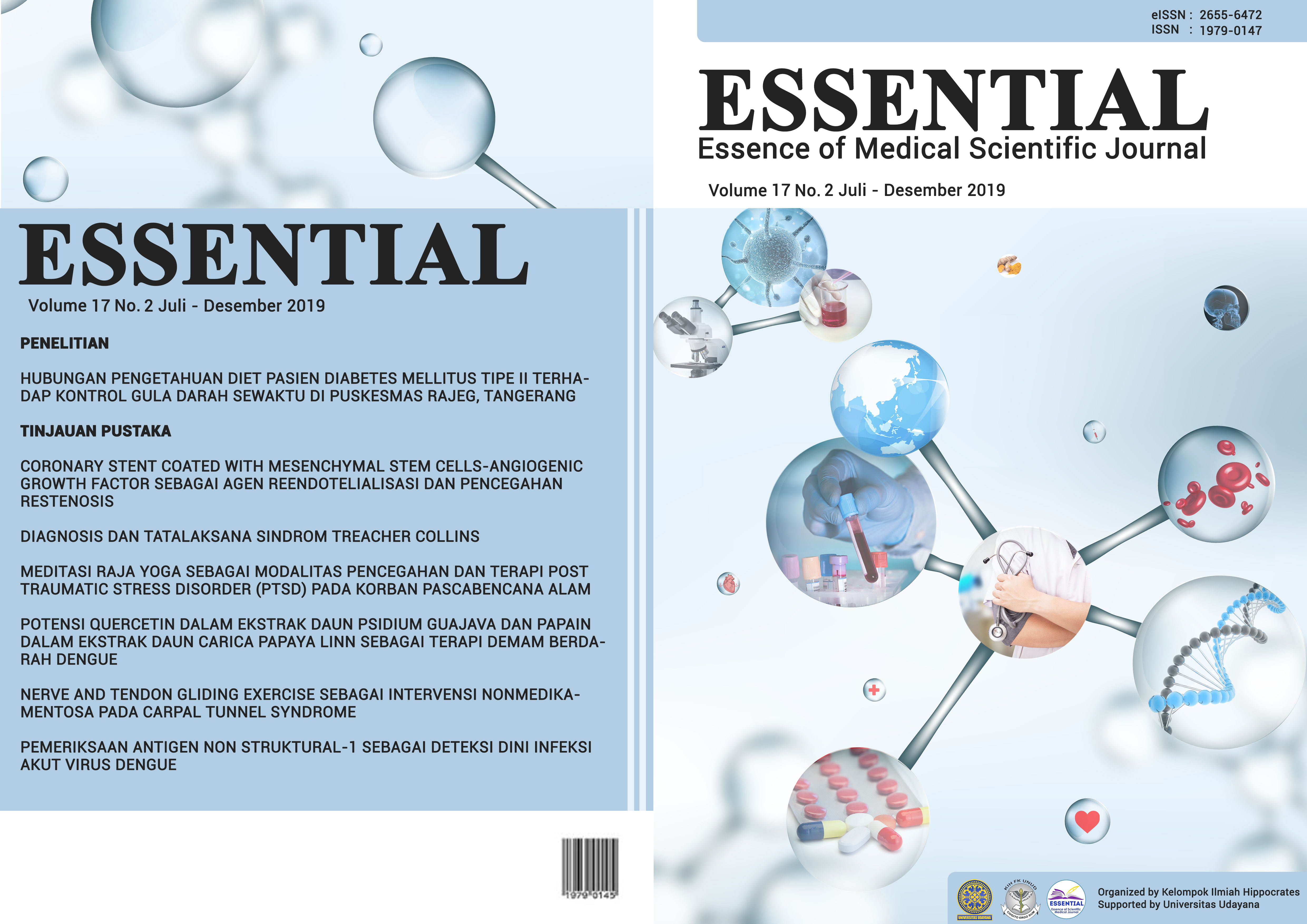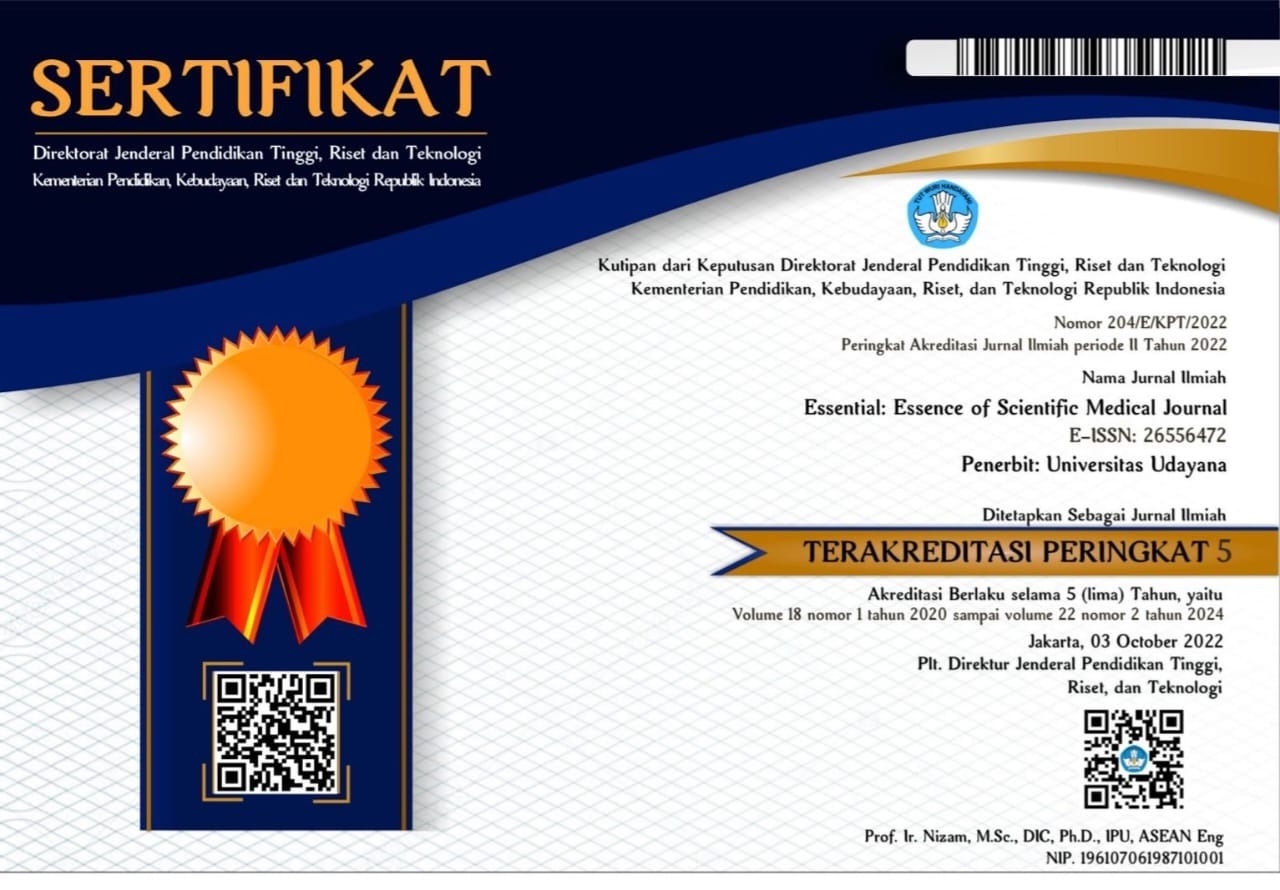MEDITASI RAJA YOGA SEBAGAI MODALITAS PENCEGAHAN DAN TERAPI POST TRAUMATIC STRESS DISORDER (PTSD) PADA KORBAN PASCABENCANA ALAM
Abstract
ABSTRAK
Pendahuluan: Indonesia merupakan negara rawan bencana alam. Sekitar 30-40% korban bencana akan mengalami Post Traumatic Stress Disorder (PTSD). Mempertimbangkan aspek neuropsikologis, PTSD dihasilkan dari kortisol dan glutamat tingkat tinggi. Sedangkan dari aspek psikodinamik, PTSD terjadi akibat menurunnya kontrol diri, rasionalitas, superego, dan kualitas mental dari dalam diri para korban akibat meningkatnya ego, yang menyebabkan mekanisme coping atau pertahanan diri.
Pembahasan: Raja Yoga terbukti meregulasi neurotransmiter serotonin dan dopamin yang mampu menekan progresivitas PTSD. Peningkatan superego akibat meditasi Raja Yoga dalam meregulasi diri juga dilibatkan untuk melunakkan mekanisme koping sehingga menurunkan perasaan cemas dan takut. Penerapan Meditasi Raja Yoga juga dapat meningkatkan ego distonik dan libidinal (id) seseorang sehingga menjadikannya lebih semangat dan bergairah yang dapat mencegah menuju PTSD. Analisis manfaat dari Meditasi Raja Yoga sebagai upaya pencegahan dan terapi pada PTSD yakni memiliki keunggulan mudah dilaksanakan, ekonomis, efisien, dan pelaksanaan latihan Meditasi Raja Yoga sangat aman. Pelaksanaan Meditasi Raja Yoga secara rutin berdasarkan hasil penelitian terbaru juga menunjukan efek yang signifikan dalam mencegah morbiditas dan progresivitas PTSD.
Simpulan: Meditasi Raja Yoga secara efektif dan signifikan mencegah perkembangan menuju terjadinya manifestasi klinis dari PTSD serta menterapi orang dengan PTSD
Kata kunci: Meditasi Raja Yoga, PTSD, Psikodinamik, Neuropsikologi
Downloads
References
1. Marlyono, S. Pengaruh Literasi Informasi Bencana Terhadap Kesiapsiagaan Masyarakat dalam Menghadapi Bencana di Provinsi Jawa Barat. Jurnal Geografi Gea, 2017;16(2):116
2. Iswanti, D. and Lestari, S. Peran Kader Kesehatan Jiwa Dalam Melakukan Penanganan Gangguan Jiwa. Jurnal Ilmu Keperawatan Jiwa. 2018;1(1):33
3. Winahayu, E., Keliat, B. and Wardani, I.. Sustainability Factor Related with the Implementation of Community Mental Health Nursing (CMHN) in South and West Jakarta. Jurnal NERS. 2016;9(2):305
4. Wardhani, Y. and Paramita, A. Pelayanan Kesehatan Mental Dalam Hubungannya Dengan Disabilitas Dan Gaya Hidup Masyarakat Indonesia (Analisis Lanjut Riskesdas 2007 Dan 2013). Media Neliti Dinas Kesehatan, 2016;19(1):99-103
5. WHO. International Classification of Fuctioning, Disability and Health, ICF World Health Organization. 2011
6. Depkes. Pengungsi Merapi Lelah, Jenuh Tak Bergairah. [Online] 2010. tersedia di: http://www.depkes.go.id/development/site/jkn/index.php?cid=1317&id=pengungsi-merapi-lelah-jenuh-tak-bergairah.html [Accessed 10 Feb. 2019]
7. American Psychiatric Association (APA). Diagnostic and Statistical Manual of Mental Disorder. Fifth Edition. Washinton DC: American Psychiatric Publishing. 2013
8. Irwanto, Faizal and Zulfa, H. Posttraumatic Stress Disorder Among Indonesian Children 5 Years After The Tsunami. Southeast Asian J Trop Med Public Health. 2015;46(5).
9. Surendra S, dkk. Post-disaster mental health and psychosocial support: experience from the 2015 Nepal earthquake. WHO South-East Asia Journal of Public Health. 2017
10. Hotmaida, L., Yogisusanti, G. and Harini, R. Kejadian Post Traumatic Syndrom Disorder (PTSD) 8 bulan Pasca Tsunami di Kabupaten Ciamis Tahun 2007 (Studi Kasus di Desa Pangandaran dan Batu Karas). Jurnal Ilmu Kesehatan Imanuel. 2008; 2(2)
11. Kurniawan, Y. and Noviza, N. Psikoterapi Interpersonal untuk Menurunkan Gejala PTSD pada Perempuan Korban Kekerasan dalam Rumah Tangga. INSAN Jurnal Psikologi dan Kesehatan Mental. 2018; 2(2):96.
12. Hendin, H. Psychodynamic Treatment of Combat Veterans with PTSD at Risk for Suicide. Psychodynamic Psychiatry. 2017;45(2):217-235
13. Ravindran, L. and Stein, M. Pharmacotherapy of PTSD: Premises, principles, and priorities. Brain Research. 2009;1293:24-39
14. Ramesh, M.G., Sathian, B., Sinu, E., dkk. Efficacy of Raja Yoga Meditation on Positive Thinking: An Index for Self-Satisfaction and Happiness in Life. Journal of Clinical and Diagnostic Research.2013; 7(10):2265-2267
15. Francois, B. Mindfulness Meditation Is More Than You Think Meditation Is More Than You Think!. PsycCRITIQUES, 2015;6060(4747).
16. Sukhsolahe, N.D., Mrunal, P.S., Sukhsolahe, S.D., dkk. Does Raja Yoga Meditation Bring Out Physiological and Psychological General Well Being Among Practitioners Of It? International Journal of Collaborative Research on Internal Medicine & Public Health. 2012;4(12): 2000-2012
17. Gallegos, A., Crean, H., Pigeon, W. and Heffner, K. 2017. Meditation and yoga for posttraumatic stress disorder: A meta-analytic review of randomized controlled trials. Clinical Psychology Review. 2017;58:115-124
18. Mohandas, E.. Neurobiology of Spirituality. Mens Sana Monographs. 2008;6(1):63
19. Herman, J.P. Central nervous system regulation of the Hypothalamic-Pituitary- Adrenal axis stress response. In C.D. Conrad (Ed.), The handbook of stress: Neuropsychological effects brain. Malden, MA.: Blackwell. 2011, 29-46
20. Thiel, K.J., & Dretsch, M.N. The basics of stress response: A historical context and introduction. In C.D. Conrad (Ed.), The handbook of stress: Neuropsychological effects on the brain. Malden, MA.: Blackwell. 2011, pp. 3-28
21. Marin, M.F., & Lupien, S.J. Stress and glucocorticoid effects on learning and memory. In C.D. Conrad (Ed.), The handbook of stress: Neuropsychological effects on the brain. Malden, MA: Blackwell. 2011, pp. 248-265
22. Harnischfeger, J. Helpful Thoughts - Some Reflections on the Psychodynamic Treatment of
23. Worby, C. Memahami segalanya tentang yoga: Tingkatkan kekuatan kelenturan, dan kesehatan anda (S.C. Simanjuntak, Trans), In Y.I.Wahyu (Eds). Jakarta: Karisma Publishing Group. 2007
24. Vago, D. R., & Silbersweig, D. A. Self-Awareness, Self-Regulation, and Self-Transcendence (S-ART) A Framework for Understanding The Neurobiological Mechanisms of Mindfulness. Frontiers in Human Neuroscience. 2012; 6:296
25. Rajoira, K. Kumar, S. Therapeutic benefits of Raj Yoga - A Review. Indian Journal of Traditional Knowledge 2017;16(1):88-95
26. Yehuda, R.. Neuroendocrine aspects of PTSD. In T. Steckler, N.H. Kalin, & J.M.H.M. Reul (Eds.), Handbook of stress and the brain: Part 2: Stress: Integrative and clinical aspects. Amsterdam: Elsevier. 2005. pp. 251 – 272
27. Nakata, H., Sakamoto, Kakigi R. Meditation reduces pain-related neural activity in the anterior cingulate cortex, insula, secondary somatosensory cortex, and thalamus. Front Psychol. 2014;5: 1489
28. Jahnke, S., dkk. Stigmatizing Attitudes Towards People with Post Traumatic and Their Malleability among Psychotherapists in Training. Elsevier. Child Abuse & Neglect. 2014. p.1-10
29. Maheshwarananda, Sri Swami. Yoga in Dialy Life: Raja Yoga [Online] 2016. Tersedia pada http://www.yogaindailylife.org/system/en/the-four-paths-of-yoga/raja-yoga. [diakses pada tanggal 6 Februari 2019]
30. Pradnya Waghmare, P.S.Baji. Effect of pranayama on cardio-respiratory efficiency. Indian Journal of Basic & Applied Medical Research. 2013;8(2):918-922
31. Gupta A, Gupta R, Sood S, Arkham M. Pranayam for Treatment of Chronic Obstructive Pulmonary Disease: Results From a Randomized, Controlled Trial. Integrative Medicine: A Clinician’s Journal. 2014;13(1):26-31
32. Poeppl, Timm B., Eickhoff, Simon B., Fox, Peter T., Laird, Angela R., Rupprecht, R., Langguth, B., dan Bzdok, D. Connectivity and Functional Profiling of Abnormal Brain Structures in Post Traumatic Stress Disorder. Wiley Periodicals, Inc.2015;36(6):1-13


 SUBMISSION
SUBMISSION
















